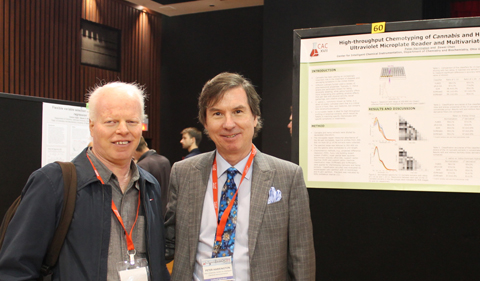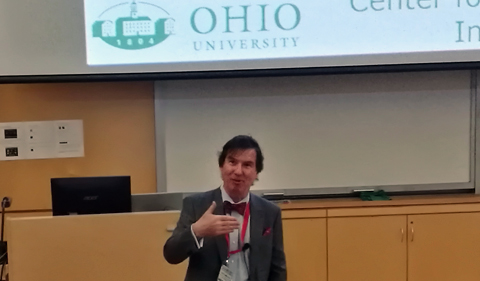Dr. Peter Harrington, Professor of Chemistry & Biochemistry, delivered a plenary address on “Cascading and Enhanced Restricted Boltzmann Machines for Feature Expansion of Spectra” at the Chemometrics in Analytical Chemistry meeting in Halifax, CA.
“Many advances in modern society are due to embedded artificial intelligence. Some of these innovations are voice recognition in phones and personal assistants, image recognition for identifying faces in photos, and digital transcription of handwriting,” noted Harrington in his abstract. “These advances rely on deep neural networks, some of which are efficiently built with layers of restricted Boltzmann machines (RBMs). RBMs have many potential applications in analytical chemistry for finding features in data. They may be used to transform data and improve the performance of classification and calibration methods that are applied to the RBM outputs. Because the goal of the RBM layer is to furnish a nonlinear transform, using a cascading network structure allows both linear and nonlinear features to be made available to subsequent chemometric methods such as partial least squares and support vector machines. Some examples will demonstrate the improvement for quantifying fat and moisture content using near-infrared spectroscopy[1]. The improvement by RBMs of the classification of spectra from botanical materials, such as Cannabis or teas, for authentication and chemotyping shall also be demonstrated.”

Hamid Abdollahi, left, is a visiting scholar and famous chemometrician from the Institute for Advanced Studies in Basic Sciences in Zanjan, Iran, and Dr. Peter Harrington, from Ohio University.
This meeting is the largest meeting in the world that is devoted to chemometrics. Dr. Hamid Abdollahi, a renowned chemometrician from the Institute for Advanced Studies in Basic Sciences in Zanjan, Iran, will be a visiting scholar at Ohio University this summer, working for 10 weeks in Harrington’s laboratory.
In addition, Harrington and graduate student Zewei Chen presented a poster on the “High-throughput Chemotyping of Cannabis and Hemp Extracts by an Ultraviolet Microplate Reader and Multivariate Classifiers.”
Abstract: Authentication of Cannabis samples from different cultivations is increasingly important since Cannabis has been used for medical purposes in the recent decade. Two samples sets of botanical extracts were studied. The first set is referred to as Cannabis that contained plant material from the sativa, indica, and hybrids of the two species. The second set, contained extracts from the variety of Cannabis sativa with low tetrahydrocannabinol (THC) concentrations (<0.2%) and is referred to as hemp. An ultraviolet microplate reader provides a cost-effective and high-throughput method for classifying 15 Cannabis and 20 hemp extracts in this study. By coupling with five multivariate classifiers, i.e. fuzzy rule-building expert system (FuRES), super partial least squares-discriminant analysis (sPLS-DA), support vector machine (SVM) and two tree-based support vector machines (SVMtreeG and SVMtreeH), good classification rates were achieved from the evaluation of bootstrapped Latin partitions. For the Cannabis extracts, SVMtreeG yielded the best performance and the classification rate is high as 99.1% for the extract/solvent ratio of 1:10 and 97.1% for the ratio of 1:20. The results from a matched sample t-test indicates that the classification for the 15 Cannabis extracts can be affected by different dilution ratios. For the hemp extracts, SVM classifier performed the best with 97.4% of classification rate. These results demonstrate that ultraviolet microplate reader coupled with multivariate classifiers can be used as a high-throughput and cost-effective approach to authenticate Cannabis and hemp extracts from different cultivations.


















Comments